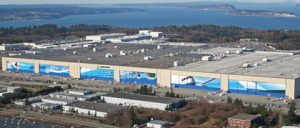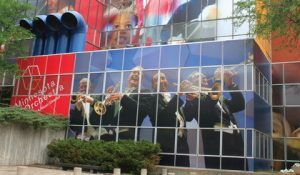Banners + Awnings
Huge
Mega-size graphics effectively promote a business or brand.
Published
16 years agoon
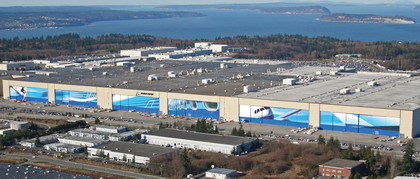
Building wraps and banners make a huge impression on consumers. An increasing number of companies and organizations have turned to these non-traditional forms of promotion and advertising because they break through visual clutter. In fact, it might not be a stretch to say the sky’s the limit.
That’s a wrap
Building wraps represent an excellent form of non-traditional marketing because they add impact and “pop” to marketing campaigns. And, when combined with billboards, vehicle wraps, floor graphics and banners, they’re a valuable component that can help blanket a neighborhood, or even an entire city, with a branding message. Because they’re suitable for all climates and unaffected by wind, building-wrap usage has grown continually. They’re now commonplace from coast to coast.
“New materials that can be applied to marble and brick have created a larger canvas,” Shad Interligi, owner of Real Hit Media (NYC), said. “Now we can take an entire facing and apply graphics. It’s exciting for customers, and it’s a big improvement. Instead of wrapping just the windows, now we can wrap the whole wall.”
Interligi, who sees an explosion in demand for building wraps, said these graphics now represent approximately 30% of his business. According to I.T. Strategies, a consultancy that helps service providers target digital-graphics markets, the outdoor-building-wrap market will grow 15% from 2006 and 2010. And, although the average lifespan for a promotional building wrap lasts approximately 30 to 90 days, media improvements stretch that figure to a year or longer.
AdvertisementNew films that bond to rough or textured surfaces, which were introduced recently, have helped spur this growth. The film and adhesives are heat-activated, which allows adhesion to such textured surfaces as concrete, brick and stucco. This film and adhesive breakthrough means graphics can now be applied to a wide variety of building surfaces, which opens new advertising outlets for digital-graphics providers and their customers.
Perforated window films, which contain a clear overlaminate similar to those used to wrap buses and other vehicles, allow building occupants to see through graphic-covered windows. To create a spectacular effect, illuminated opaque or translucent films offer a spectacular nighttime advertising opportunity.
Banner days
Banners can dramatically promote a product or brand, but the project’s size and material’s weight must be considered to determine what’s appropriate. Solid banner material weighs roughly twice as much as a mesh.
Wind can significantly affect a banner’s lifespan; mesh banners allow some wind to pass through without tearing. Depending on the banner’s size, wind can also create installation challenges. Always make sure your fabricator and installer have considered the design of the project’s mounting system, the wind-load tolerance and the banner’s weight prior to installation.
Before drilling holes and attaching hardware anchors, determine mounting options and attachment points for initial, exterior-banner installations. This facilitates subsequent installations that use pre-existing hardware. The material’s weave also needs to be considered. An open weave weighs less and allows more air to flow through the banner, whereas tighter weaves better suit smaller banners and locations with less wind load. A tighter weave shows greater image detail, which may matter when the graphic is closely viewed.
AdvertisementIn today’s tough economic times, people may cut corners to reduce costs. For interior installations, a banner may need to meet local fire codes. Always ask your installer for certification that verifies the material meets flame-resistance requirements. Otherwise, an inexpensive banner could cost exponentially more if it catches fire.
Flying wide
With a cavernous, 4.3 million sq. ft., Boeing’s commercial-airliner factory near Seattle has been recognized by the Guinness Book of World Records as the world’s largest-volume building. Its six hangar doors each measure 83 ft. tall and 300 to 354 ft. wide – almost the size of a football field. In the past, individual graphics were applied to the doors, but Boeing officials wanted a global look consistent with its brand. They hired Seattle-based SuperGraphics to fabricate a 100,000-sq.-ft. mural that celebrates the “dream of flight.”
“We wanted the doors to reflect the passion for airplanes of those who work behind the hangar doors, making the dream of flight real every day,” Jeff Robinson, Boeing’s marketing director and project supervisor, said. “We also wanted to share that pride with the community.”
According to Ryan Broderson, SuperGraphics’ business-development manager, the shop printed the graphics at 25 dpi. However, even at that low resolution, such colossal graphics generated files that measured 2GB per door. Super-Graphics subsequently halved each door into 1GB files using SmartScale, a Photoshop® plugin.
AdvertisementBroderson added, “To lay out and inspect the graphics before installation, we rented an entire basketball gym. This is the first time a job has required this.” Because of the frequent traffic through the hangar doors, SuperGraphics installed the graphics using hydraulic snorkel lifts. During the project’s latter stages, installers encountered a Pacific Northwest trifecta – rain, cool temperatures and wind.
“We endured the rainiest fall and winter Seattle’s had in 50 years,” Broderson said. “We had to work quickly when the weather allowed.”
The result is not only the world’s largest digital graphic (according to Guinness) but, according to Robinson, “an awe-inspiring image that captures the wonder of flight and our passion for building the world’s preferred airplanes.”
An optical symphony
In the spring of 2006, the Minnesota Orchestra wanted to promote ticket sales for the fall’s performance schedule. Someone sagely suggested wrapping the entire building in graphics and providing a whole new platform to launch promotional opportunities. The orchestra’s management subsequently hired Minneapolis-based Vomela to design and fabricate the wrap. Color Graphics Installation Service (Andover, MN) handled installation; Jeff Olson, Color Graphics’ owner, praised Vomela’s process for facilitating installation.
“We selected great images that show what happens inside the building, and planned to keep the graphic on the building from September to May,” Gwen Pappas, public-relations manager for the Minnesota Orchestra, said: “It went up, and people loved it. We’ve only received great feedback on how nice the building looks.”
Understandably for an outdoor Minnesota installation, the air temperature looms as a significant factor. Olson said, “Vinyl manufacturers normally provide maximum and minimum temperature guidelines for installations. But, the ambient temperature can fool you. If the surface is away from the sun, the surface may be too cold. Or, direct sun exposure can make it too hot.”
Patrons, board members and international visitors provided such positive feedback the orchestra decided to keep it and replace sections annually to keep the graphics fresh. Part of the original 60 x 40-ft. graphic, which features the orchestra’s Finnish conductor, Osmo Vänskä, remains nearly three years later. Each spring, minor patchwork repairs are made, but, in general, it’s weathered beautifully.
Last fall, Vomela installed a new image of the orchestra’s trumpet section in the midst of a jam session. Pappas asked the section members to play a fanfare on the roof above the wrap on Opening Night before the orchestra’s performance. The move stirred excitement among patrons and resulted in a front-page article and photo in the Minneapolis StarTribune.
“Wrapping Orchestra Hall seemed like a daunting concept, but it was relatively simple because the mechanics were so well handled by the professionals who installed it,” Pappas said. “It has far surpassed what we expected; the impact was so large. We’re the only orchestra to have done this, and it’s been great. Any future renovation plans will include these supergraphics.”
Tim Boxeth, who has 13 years of experience with large-format graphics, is market-development manager for the St. Paul, MN-based 3M Graphics Market Center.

SPONSORED VIDEO
Introducing the Sign Industry Podcast
The Sign Industry Podcast is a platform for every sign person out there — from the old-timers who bent neon and hand-lettered boats to those venturing into new technologies — we want to get their stories out for everyone to hear. Come join us and listen to stories, learn tricks or techniques, and get insights of what’s to come. We are the world’s second oldest profession. The folks who started the world’s oldest profession needed a sign.
You may like

Making the Grade with ADA Signs

AI, Big Survey, You Know You’re a Sign Pro Reactions and More in May’s Inbox

INX Releases 2023 Sustainability Report
Subscribe

Bulletins
Get the most important news and business ideas from Signs of the Times magazine's news bulletin.
Most Popular
-

 Real Deal2 weeks ago
Real Deal2 weeks agoA Woman Sign Company Owner Confronts a Sexist Wholesaler
-

 Projects2 weeks ago
Projects2 weeks agoGraphics Turn an Eyesore Cooler Into a Showpiece Promo in Historic Plaza
-

 Projects2 days ago
Projects2 days ago4 of the Most Fun Sign Projects in Years
-

 News3 days ago
News3 days ago2024 Sign Contest Open for Submission
-

 Business Management1 week ago
Business Management1 week ago3 Things Print Pros Must Do to Build Stronger Relationships in the Interiors Market
-
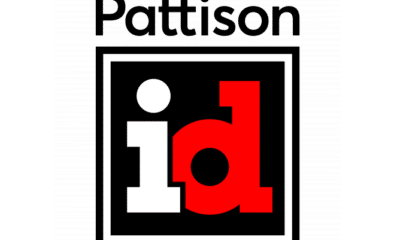
 News2 weeks ago
News2 weeks agoPattison ID New Name of Five Companies
-

 Manager's To Do1 week ago
Manager's To Do1 week agoMarketing Signs to Schools, Tradeshow and Quote Follow-up Make May’s List
-
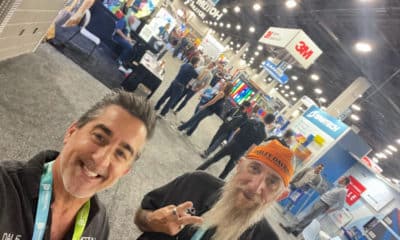
 Dale Salamacha1 week ago
Dale Salamacha1 week agoWhat Makes the Perfect Sign Business Partnership
